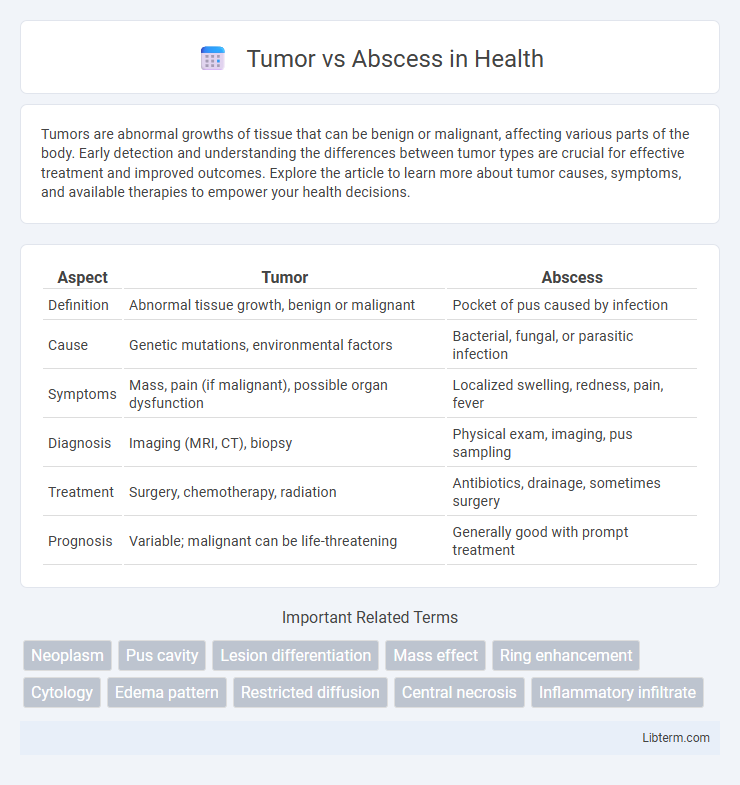Tumors are abnormal growths of tissue that can be benign or malignant, affecting various parts of the body. Early detection and understanding the differences between tumor types are crucial for effective treatment and improved outcomes. Explore the article to learn more about tumor causes, symptoms, and available therapies to empower your health decisions.
Table of Comparison
| Aspect | Tumor | Abscess |
|---|---|---|
| Definition | Abnormal tissue growth, benign or malignant | Pocket of pus caused by infection |
| Cause | Genetic mutations, environmental factors | Bacterial, fungal, or parasitic infection |
| Symptoms | Mass, pain (if malignant), possible organ dysfunction | Localized swelling, redness, pain, fever |
| Diagnosis | Imaging (MRI, CT), biopsy | Physical exam, imaging, pus sampling |
| Treatment | Surgery, chemotherapy, radiation | Antibiotics, drainage, sometimes surgery |
| Prognosis | Variable; malignant can be life-threatening | Generally good with prompt treatment |
Understanding Tumors and Abscesses
Tumors are abnormal masses of tissue formed by uncontrolled cell growth, often classified as benign or malignant, whereas abscesses are localized infections characterized by pus accumulation caused by bacterial invasion. Understanding the distinct pathology of tumors and abscesses is critical for accurate diagnosis, relying on imaging modalities like MRI and CT scans alongside biopsy for tumors and pus culture for abscesses. Effective treatment for tumors involves surgery, chemotherapy, or radiation, while abscess management requires antibiotics and surgical drainage to prevent systemic infection.
Key Differences: Tumor vs Abscess
Tumors are abnormal growths of tissue that can be benign or malignant, while abscesses are localized collections of pus due to infection. Tumors typically develop gradually and may not cause pain initially, whereas abscesses often present with acute pain, redness, and swelling. Imaging studies and biopsy help differentiate tumors from abscesses, guiding appropriate treatment strategies.
Causes and Risk Factors
Tumors arise from abnormal and uncontrolled cell growth due to genetic mutations, carcinogen exposure, or inherited predispositions, with risk factors including smoking, radiation, and chronic inflammation. Abscesses result from localized infections typically caused by bacteria such as Staphylococcus aureus or Streptococcus species, with risk factors including immune suppression, trauma, and poor hygiene. Both conditions involve tissue swelling but differ fundamentally in etiology: neoplastic versus infectious origins.
Symptoms: How Tumors and Abscesses Present
Tumors often present with gradual, persistent symptoms such as a painless lump, unexplained weight loss, and systemic signs like fatigue or night sweats. Abscesses typically manifest as localized swelling, redness, warmth, and severe pain accompanied by fever and sometimes pus drainage. Differentiating based on symptoms is critical since tumors reflect abnormal cell growth while abscesses indicate infection and inflammation.
Diagnostic Methods and Imaging
Diagnostic methods for distinguishing tumors from abscesses primarily rely on imaging techniques such as MRI and CT scans, which provide detailed visualization of lesion characteristics. Tumors typically exhibit irregular borders and heterogeneous enhancement patterns, whereas abscesses display a well-defined capsule with central fluid necrosis and restricted diffusion on diffusion-weighted imaging (DWI). Complementary diagnostic tools like ultrasound and biopsy guide accurate differentiation, ensuring appropriate treatment strategies.
Treatment Options for Tumors
Treatment options for tumors primarily include surgical resection, chemotherapy, and radiation therapy, depending on the tumor type and stage. Targeted therapies and immunotherapies are increasingly used to improve outcomes in specific cancers like glioblastoma and breast cancer. Early diagnosis and multidisciplinary management are critical for optimizing tumor treatment efficacy and patient survival rates.
Treatment Approaches for Abscesses
Treatment approaches for abscesses primarily involve incision and drainage to remove purulent material and reduce infection. Antibiotic therapy, tailored to the causative bacterial pathogens, supports recovery but is often insufficient alone without drainage. Ultrasound guidance can improve drainage accuracy, especially for deep or complex abscesses, enhancing clinical outcomes.
Prognosis and Potential Complications
Tumor prognosis varies widely depending on malignancy, size, and location, with malignant tumors often leading to metastasis and organ dysfunction. Abscess prognosis is generally favorable with prompt antibiotic therapy and drainage, but delayed treatment can cause sepsis, tissue necrosis, and systemic infection. Complications of tumors include local invasion, hemorrhage, and paraneoplastic syndromes, whereas abscess complications primarily involve spreading infection and chronic fistula formation.
Prevention and Early Detection
Effective prevention of tumors involves minimizing exposure to known carcinogens, maintaining a healthy lifestyle, and undergoing regular screenings such as mammograms or colonoscopies for high-risk individuals. Early detection of abscesses relies on prompt recognition of localized pain, swelling, and fever, followed by medical imaging techniques like ultrasound or CT scans to confirm diagnosis. Timely intervention reduces complications for both conditions, emphasizing the importance of routine health check-ups and awareness of initial symptoms.
When to Seek Medical Attention
Seek medical attention immediately if a lump or swelling grows quickly, causes severe pain, or is accompanied by fever and redness, as these signs may indicate an abscess or an aggressive tumor. Persistent, unexplained lumps without infection symptoms should also be evaluated promptly to rule out malignancy. Early diagnosis through imaging and biopsy can differentiate between tumor and abscess, ensuring timely and appropriate treatment.
Tumor Infographic

 libterm.com
libterm.com